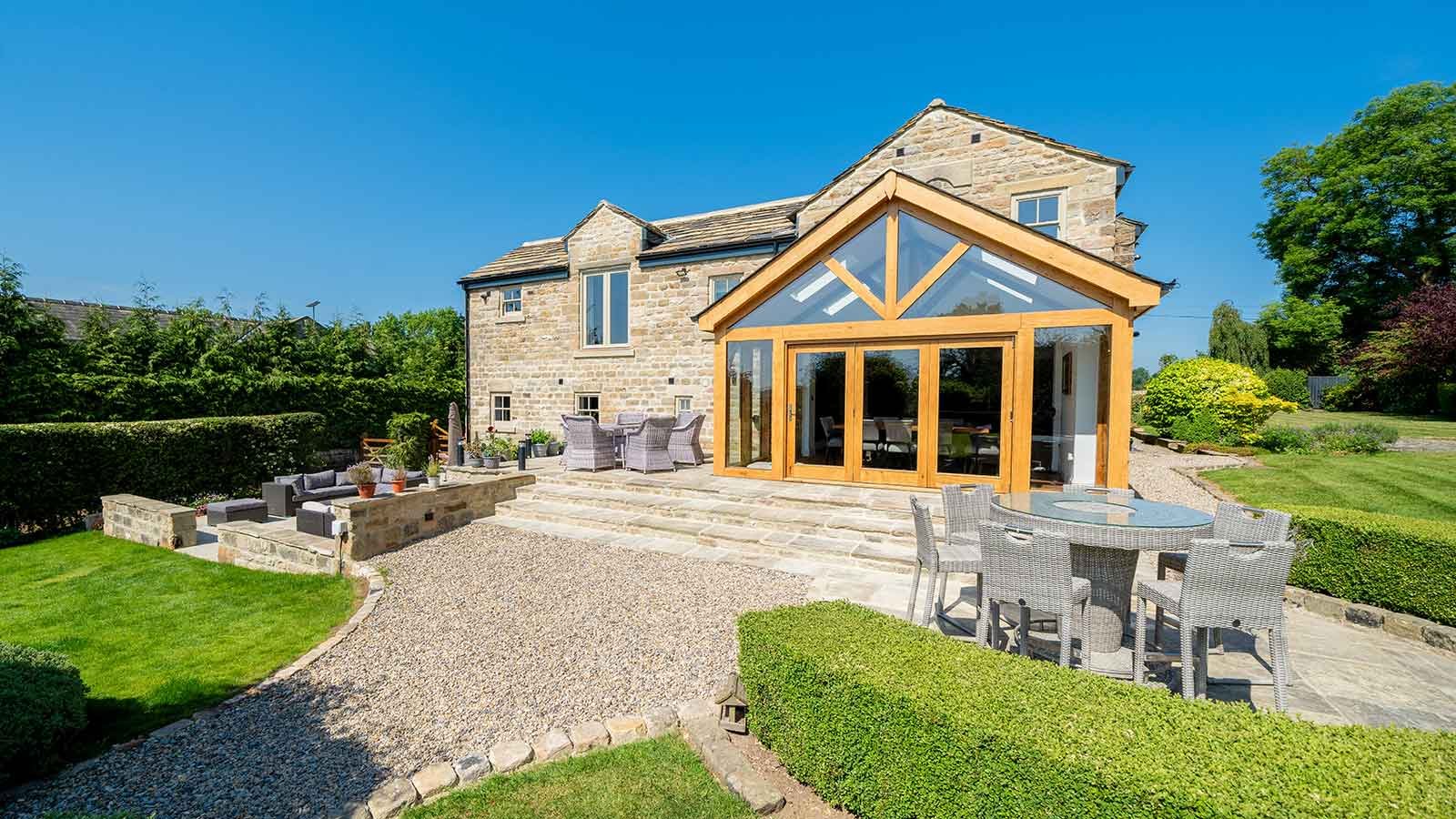
oakbydesign
01423 593 794


Nigel Middleton and his wife, Elizabeth, were introduced to Jamie Winspear, by a friend. Their friend had bought their engineered oak flooring and an oak porch a number of years previously, after suffering a flood.
Jamie had an initial meeting with the couple, who were just looking for an oak sunroom at the end of their house where they could sit and enjoy the garden and views.
After providing a few design ideas, Nigel asked Jamie about extending the house further, which involved major building alterations.
Their property is a beautiful, detached, stone-built house in its own grounds on the south side of Harrogate, and it had the room to increase in size.
Oak By Design have worked with architects, Stott Thompson based in Boston Spa for many years. Jamie recommended Howard Thompson to work alongside Nigel and Elizabeth on the full scheme.
Stott Thompson Architects provided new designs and once the couple were happy with them, they submitted them for planning. Several weeks afterwards, Planning Permission was approved.
The architects then worked alongside us to provide Nigel and Elizabeth with full detailed drawings. They asked Jamie for recommendations to carry out the building works.
Having worked alongside Hue Interiors, based in Wetherby, on several previous projects. Jamie, therefore, recommended them to the Middletons.
They asked Jamie to then provide a quotation for the proposed 5m x 5m sunroom, which was to be an important focal point of the renovation, allowing Nigel and Elizabeth to enjoy the garden and views.
The sunroom design included a oak gable end complete with glass and an oak feature timber truss supporting the vaulted roof, and bi-fold doors, allowing Nigel and Elizabeth to really take in the garden and bring in fresh air and light.
They also asked us to provide a quotation for oak flooring for 2 en-suites, the dressing room, the living room, the entertainment room and kitchen.
After viewing the samples, Nigel and Elizabeth chose the Kolonial option. Kolonial is a brushed board which highlights the grain. They chose board widths of 190mm wide which is a nice width which suits large and small rooms alike.
They chose the Cognac colour for the kitchen and entertainment room. This can be seen on the photo’s.
As the living room is quite traditional they chose a darker board, in the Gothic colour.
Still keeping with the Kolonial finish they chose Smoked White in a herringbone board for the 2 en-suites and dressing room. These boards add a lot of interest to a room, especially in a smaller room.
Once all the quotations were received, Nigel and Elizabeth asked for everyone to proceed.
Hue Interiors started with the building works, and ourselves commenced manufacture timber frame.
As soon as Hue Interiors had completed their works, to the point where the oak sunroom could be installed, our installation team carried out their full installation works. This consisted of installing theoak framework, the glazing, the roof installation and all doors and frames, leaving a water tight structure, ready for the internal finishes to be carried out by Hue Interiors,
Once all the internal finishes, (such as plaster works, electrics, plumbing etc) were complete, we returned to install the engineered oak flooring to all the rooms.
The light coloured herringbone flooring in the dressing room complements the dark cupboards perfectly.
Hue Interiors installed the bespoke kitchen, seen on the photo’s below, finished in Farrow and Ball’s Hague Blue. This lovely deep blue tones perfectly with the deep tones of the Cognac flooring, offset by the beautiful bright white marble worktop,.
Access from the oak framed building on a sunny day is made through the 3 oak bifold doors. A single Pattern 10 door is used for everyday accessing of the garden.
Speaking to the couple shortly afterwards they said
“We couldn’t be happier with the end result, we have actually enjoyed the experience. Jamie led the way and introduced us to a really fantastic team of professionals. Hue Interiors, Stott Thompson Architects and ourselves all worked together cohesively, providing good humour and positivity throughout the project. We have been left with a stunning home to enjoy for many years to come. We couldn't be happier"
Oak conservatories have long been revered for their timeless appeal and classic beauty. These exquisite structures serve as a testament to the craftsmanship and elegance that defined architectural design in bygone eras.
One anachronism can be witnessed in the way these conservatories evoke a sense of nostalgia, transporting individuals to a time when life seemed simpler and more refined. The amalgamation of modern technology with traditional aesthetics creates a paradoxical experience that tugs at the heartstrings of those who appreciate the charm of yesteryears.
From an academic standpoint, oak conservatories exemplify the principles of enduring architecture. Their sturdy frames and elegant lines stand as testaments to their durability and longevity. Crafted from carefully selected oak, these structures harmoniously blend with both historic and contemporary settings, seamlessly bridging past and present.
The use of objective language allows us to examine the technical aspects of oak conservatory construction without personal bias or subjective interpretation. Traditional joinery techniques ensure precise fitting, resulting in seamless connections between components. This meticulous attention to detail not only enhances structural integrity but also adds an aesthetic element that cannot be replicated by mass-produced alternatives.
Oak conservatories embody a sense of grandeur that is unparalleled. Their expansive glass walls allow natural light to flood the interior spaces, creating an ethereal atmosphere that is conducive to relaxation and contemplation. Whether used as additional living spaces or garden sanctuaries, these structures have become iconic symbols of refined elegance throughout history.
Green oak and air-dried oak are two distinct types of timber that differ in their characteristics. Understanding these differences is crucial for anyone involved in the construction or woodworking industry.
When comparing green oak to air-dried oak, one can draw an analogy with the concept of ageing wine. Just as wine needs time to mature and develop its unique flavors, green oak requires a seasoning process to achieve optimal quality.
During the seasoning process, green oak gradually loses moisture content through natural drying methods. This reduction in moisture not only improves the stability of the wood but also prevents excessive movement and shrinkage over time. It is comparable to how ageing wine develops complexity while maintaining stability.
On the other hand, air-dried oak undergoes a different drying method. Once cut into sizeable timber pieces, it is left outside to dry naturally over an extended period. The exposure to open air allows for gradual moisture loss through evaporation, resulting in lower moisture content compared to green oak.
The metaphorical comparison between green oak and aging wine helps illustrate how both processes require patience and time for desirable outcomes. Just as aged wine showcases its refined qualities after years of maturing, air-dried oak represents a stable and reliable material due to its prolonged seasoning period.
In summary, understanding the distinction between green oak and air-dried oak is essential when choosing timber for construction purposes. Whether opting for freshly felled or naturally dried wood, each has its advantages based on specific project requirements and desired characteristics.
Double glazing, also known as a double glazed unit (DGU), is a widely used element in building construction due to its numerous benefits. This article aims to discuss the advantages of double glazing within the context of thermal insulation.
The primary advantage of incorporating double glazing into building design lies in its ability to provide effective thermal insulation. By utilising two sheets of glass separated by a spacer bar, an air gap is created within the DGU, which can be filled with an insulating gas. This configuration acts as a thermal barrier, preventing heat from escaping and cold air from infiltrating a room.
To illustrate this phenomenon, we can imagine the DGU functioning like a sandwich. The sheets of glass serve as the bread slices while the air gap represents the filling. Just as a sandwich preserves warmth and prevents external elements from permeating it, double glazing similarly retains heat within enclosed spaces while impeding cold drafts from entering.
This enhanced insulation results in improved energy efficiency for buildings that incorporate double glazed windows. By reducing heat loss during colder months and minimizing heat gain during warmer months, these windows contribute to maintaining comfortable indoor temperatures without excessive reliance on heating or cooling systems.
In conclusion, through its thermal insulation properties, double glazing plays a crucial role in enhancing the energy efficiency of buildings. By utilising this technology, builders can create more sustainable structures that optimise comfort while reducing energy consumption and associated costs over time.
Telephone: 01423 593 794
Locksley Park
Blind Lane
Tockwith
YORK YO26 7QJ
Opening Times:
Mon to Fri - 9.00am to 5.00pm
Bank Holidays - Closed
Christmas 2025- TBC
Oak By Design is the trading name of:
Oak By Design Ltd.
Reg Number: 04384416
VAT Number: 664 8012 33